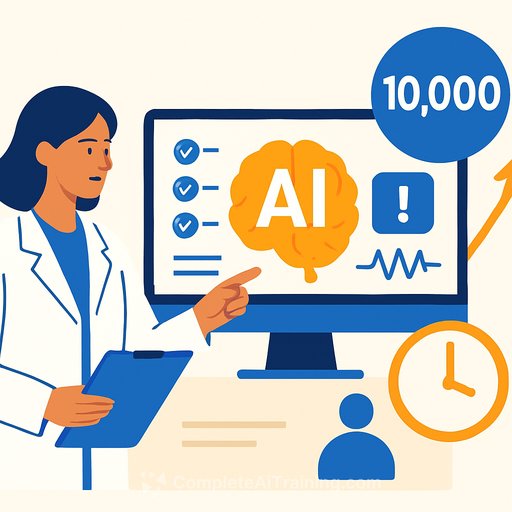Smarter, Safer Hospitals: How HCA Healthcare Is Using AI to Redefine Patient Safety
October 16, 2025 - Safety is the baseline for everything else in care. Regulatory compliance, clinical outcomes, finances, and reputation all depend on it. That is the standard set by Randy Fagin, M.D., chief quality officer at HCA Healthcare, in conversation with Chris DeRienzo, M.D.
HCA Healthcare is combining cross-industry lessons with artificial intelligence to monitor risk earlier, reduce variance in care, and support clinicians at the point of decision. The focus is simple: prevent harm upstream, not just count events downstream.
Borrowing from high-reliability industries
HCA Healthcare studied aviation, manufacturing, and military operations to build a scalable safety model. Teams visited GE's CT manufacturing plant, DuPont Chemical, and the U.S. Army's 160th Special Operations Aviation Regiment to learn how complex organizations reduce error and create predictable outcomes.
Those practices are being adapted to clinical operations and care delivery - translating proven safety patterns to the bedside.
AI as a force multiplier for safety
Traditional safety programs rely on events like infections or falls. AI adds digital markers for near misses and leading indicators so risk is visible earlier. As Fagin put it, AI does not replace the model - it accelerates it and enables new capabilities.
The goal is proactive surveillance and timely intervention, not retrospective reporting.
Governance that goes beyond clinical
Effective AI starts with clear governance. HCA Healthcare includes leaders across operations, finance, marketing, supply chain, and clinical teams to vet each use case from every angle. That means clinical impact, operational feasibility, financial viability, and patient experience are all weighed before deployment.
This discipline prevents orphan pilots, reduces unintended consequences, and speeds adoption.
Reduce variance, improve consistency
AI helps surface where care varies: clinician decisions, patient presentations, and regional differences. By making variation visible, HCA Healthcare can standardize to what works best and deliver that level of care more reliably across its footprint.
The target is consistent excellence - raising the floor, not just the average.
Frontline first: AI that augments, not replaces
Frontline engagement starts at design. Nurses, physicians, and support staff validate the problem, shape workflows, and pressure-test outputs before scale. That buy-in is non-negotiable for real adoption.
The principle is augmentation. Technology supports clinical judgment and clears administrative noise so clinicians can focus on patients.
Real-world applications
AI-driven nurse staffing
AI models align staffing with patient acuity, shift patterns, and nurse preferences. The result: lighter administrative load and schedules that adjust in real time to census and acuity shifts.
The lesson: involve the people closest to the work early, or you will build the wrong tool and pay for it later.
Ambient AI for documentation
Ambient-listening tools in EDs and inpatient units capture clinician-patient conversations and generate draft notes for physician review. Hours of documentation can be removed from the workday, while records become more complete and accurate.
Better notes, less friction, more time with patients.
Fetal heart rate monitoring
In partnership with GE HealthCare, HCA Healthcare is training an AI model to recognize key portions of fetal heart rate tracings and support timely decisions. The model is being submitted for FDA review.
Continuous monitoring at scale is a natural fit for AI, especially where risk materializes quickly and human eyes cannot be everywhere.
GE HealthCare | FDA: AI/ML in SaMD
How leaders can apply this model
- Declare safety as the primary operating objective. Every metric rolls up to it.
- Benchmark outside healthcare. Borrow proven safety practices from aviation, manufacturing, and the military.
- Build cross-functional AI governance. Include clinical, operations, finance, supply chain, compliance, and patient experience.
- Start small with low-risk pilots. Prove value, measure drift, and scale with guardrails.
- Prioritize variance reduction. Standardize to best-performing patterns, then monitor adherence.
- Design with frontline teams. Co-create workflows, feedback loops, and escalation paths.
- Measure upstream. Track leading indicators and near misses, not just adverse events.
- Aim for augmentation. Keep clinicians in control; use AI to reduce noise and surface signal.
Key takeaways
- Safety is non-negotiable and foundational to compliance and outcomes.
- Look beyond health care to raise the reliability bar.
- Use AI to anticipate risk and reduce variation, not just report after the fact.
- Start with focused pilots and expand with evidence.
- Support clinician judgment while improving decision quality.
What's next
HCA Healthcare shows how cross-industry learning, AI, and frontline collaboration can improve patient safety at scale. For more context, listen to the Advancing Health podcast discussion referenced in this article (Part 1 and Part 2).
If you are building AI literacy for your clinical or operations teams, explore curated resources by role at Complete AI Training - Courses by Job.
Your membership also unlocks:






